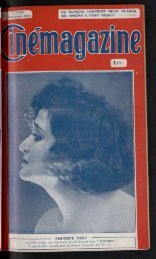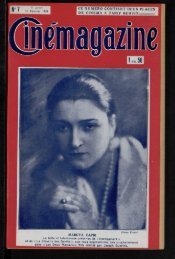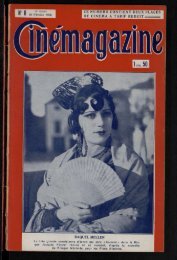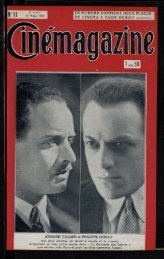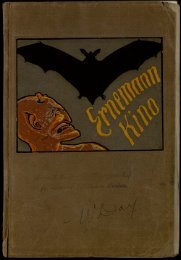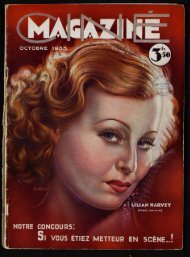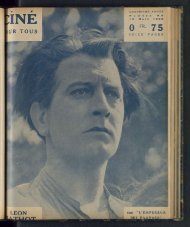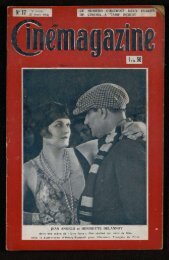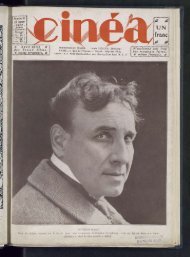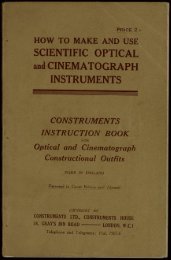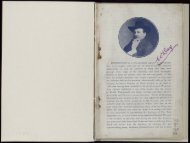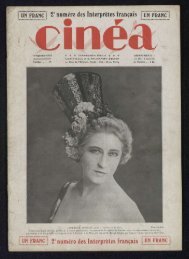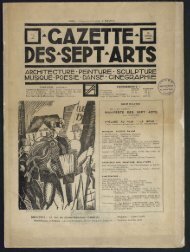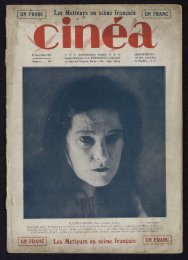Untitled
Untitled
Untitled
You also want an ePaper? Increase the reach of your titles
YUMPU automatically turns print PDFs into web optimized ePapers that Google loves.
8 MODERN MAGIC LANTERNS.<br />
flame, the channels through which they pass being in a<br />
direct line with the chimney ; the light given by this form<br />
is very satisfactory.<br />
The following directions for the use of oil lamps may be<br />
taken, except where otherwise stated, as applying to all<br />
patterns, and should receive careful attention if it is desired<br />
to get the best result :<br />
The selection of the oil should not be left to mere chance,<br />
nor half a pint of the cheapest " paraffin " got at the nearest<br />
oilshop on the evening when it is required. Many of<br />
the oils in the market, although perfectly safe in household<br />
lamps in which the reservoir is of porcelain or other<br />
material which is a bad conductor of heat, are positively<br />
dangerous in the optical lantern, where, from the very nature<br />
of the instrument and the exigencies of construction, the<br />
receptacle for the oil is bound to get, at any rate, warm.<br />
The best crystal oil must be got from a reliable dealer. The<br />
addition of a lump of camphor about the size of a walnut to<br />
each pint of oil has been recommended as making the light<br />
whiter, but we have never been able to detect any improvement<br />
in illumination by this means, over that got by theuse of<br />
the best " crystal " oil. The wicks should not be too long, and<br />
of course not too short, a couple of inches longer than<br />
necessary to reach to the bottom of the oil reservoir is<br />
ample ; before use they should be thoroughly dried. When<br />
dry, the wicks, if new, must be trimmed with a pair of<br />
scissors and replaced in the lantern, the reservoir filled<br />
nearly full, whether the lantern is wanted to burn for ten<br />
minutes or two hours, and after the lapse of a minute or<br />
two for the wicks to soak they should be lit and allowed to<br />
burn for a quarter of an hour. A funnel should always be<br />
used for filling, and the greatest care taken to avoid spilling<br />
any of the oil about the lamp, as it is only by such precautions<br />
that the unpleasant smell can be avoided. The<br />
chimney is best kept off for the first minute, and put on<br />
when the lamp is seen to be fairly alight.<br />
When the new wicks have burnt for a short time, they<br />
can be trimmed once more with a sharp pair of scissors, so<br />
as to give a perfectly even flame ; this trimming can only be<br />
roughly done before the edges have been charred by use.<br />
kliliiiI1I1M<br />
OIL LAMPS. 9<br />
They should be trimmed each time before use, but only that<br />
part which is quite burnt need be cut off.<br />
When the lamp is lit, it should be turned up fully at once,<br />
and for the first few minutes must be watched, and turned<br />
down a little as the lantern warms and the flame begins to<br />
smoke, until it is seen to be burning regularly and steadily. To<br />
avoid smell as much as possible, the lamp is never to be<br />
allowed either to smoke or to burn below its maximum, the<br />
greatest height of flame short of actual smoking being always<br />
in use ; this will entail more or less constant attention,<br />
but will obviate annoyance to the noses of the audience.<br />
Another point which must be seen to, is that each of the<br />
wicks is doing its fair share of the work. With two-wick<br />
lamps this is the case when each is burning so high that<br />
any increase in the height of the flame of either will cause a<br />
smoke. With lamps possessing three or more wicks, the<br />
inner wick or wicks should be in this condition ; the outer<br />
ones are best a trifle lower.<br />
When the chimney is adjustable in height, the lamp<br />
should be removed from the lantern and the height of<br />
chimney at which the light is at its best ascertained by experiment;<br />
when found, the point should be marked on the<br />
chimney once for all. If, now, when he lamp is replaced in<br />
the lantern, the height requires altering to get the best<br />
result, it indicates that the air inlets are not sufficiently free.<br />
This is not often the case ; in fact, as a general rule, the<br />
inlets for the air receive more attention from the makers<br />
than the outlet at the chimney, which is sometimes so contracted<br />
as to counteract the advantages gained by improved<br />
inlets ; still, in good lamps, both matters are the subject of<br />
careful study and experiment.<br />
After a display, the lamp should be emptied of oil, the<br />
wicks taken out, squeezed up in paper to free them from oil,<br />
and put away until wanted again, and the metal parts of the<br />
lamp washed with washing soda and warm water and dried.<br />
If a little trouble in this way is taken with a petroleum<br />
lamp, it can be used with almost an entire freedom from<br />
smell, and the results will astonish those whose experience<br />
of the oil lamp is gleaned from the greasy, messy abominations<br />
which, with a little inattention, they readily become.



